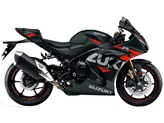Yamaha R1 2019 vs. Suzuki GSX-R 1000 2017

Yamaha R1 2019

Suzuki GSX-R 1000 2017
Vue d’ensemble - Yamaha R1 2019 vs Suzuki GSX-R 1000 2017
The Yamaha R1 model year 2019 and the Suzuki GSX-R 1000 model year 2017 are both high-performance supersport motorcycles that cater to the needs of experienced riders who seek adrenaline-pumping rides on the track. While both bikes share similar features and specifications, there are notable differences that set them apart.
Starting with the engine and drive train, the Yamaha R1 2019 is equipped with a 998cc engine that produces 200 horsepower and 112.4 Nm of torque. On the other hand, the Suzuki GSX-R 1000 2017 boasts a slightly more powerful 999cc engine, delivering 202 horsepower and 118 Nm of torque. Both bikes feature a 4-cylinder DOHC engine with 4 valves per cylinder and a high compression ratio of 13 or 13.2 respectively. However, it is worth noting that the Yamaha R1 has a larger bore size of 79mm compared to the Suzuki's 76mm, which may contribute to its slightly lower power output.
In terms of suspension, both bikes feature upside-down telescopic forks at the front, ensuring optimal stability and control during aggressive riding. The chassis of both motorcycles is made of lightweight aluminum, providing a perfect balance between rigidity and agility. However, the Yamaha R1 utilizes a Deltabox frame, while the Suzuki GSX-R 1000 features a Twin Tube, Twin-Spar frame. This difference in frame design may result in variations in handling characteristics and overall feel.

Yamaha R1 2019
When it comes to braking, both motorcycles are equipped with double disk brakes at the front, ensuring excellent stopping power and control. Additionally, both bikes feature advanced rider assistance systems such as traction control, which enhance safety and performance on the track. The Yamaha R1 also boasts launch control, which aids in achieving optimal acceleration from a standstill.
In terms of dimensions and weights, the Yamaha R1 has a slightly shorter wheelbase of 1405mm compared to the Suzuki's 1410mm. The seat height of the Yamaha R1 is 855mm, while the Suzuki GSX-R 1000 sits slightly lower at 825mm. Both motorcycles have a fuel tank capacity of around 17 liters, allowing for extended riding sessions without frequent refueling. The Yamaha R1 weighs 199kg with ABS, while the Suzuki GSX-R 1000 weighs slightly more at 202kg.

Suzuki GSX-R 1000 2017
Moving on to the strengths of each bike, the Yamaha R1 2019 is praised for its powerful engine and clean response. In the right hands, it is considered a very fast track bike, thanks to its perfectly tuned electronics. On the other hand, the Suzuki GSX-R 1000 2017 is known for its high-revving engine and super stable performance on corner exits and radii. It is also highly regarded for its great quickshifter and high-quality chassis, making it a terrific choice for fast tracks.
However, both bikes have their weaknesses. The Yamaha R1 2019 has been criticized for its ABS system, which is not deemed 100% satisfactory by some riders. On the other hand, the Suzuki GSX-R 1000 2017 lacks an adjustable engine brake, which may limit customization options for riders who prefer a specific braking feel.
In conclusion, both the Yamaha R1 2019 and the Suzuki GSX-R 1000 2017 are exceptional supersport motorcycles that offer exhilarating rides on the track. While the Yamaha R1 boasts a powerful engine and perfectly tuned electronics, the Suzuki GSX-R 1000 excels in stability, quickshifting, and chassis quality. Ultimately, the choice between these two bikes depends on individual preferences and priorities.
Caractéristiques techniques Yamaha R1 2019 par rapport à Suzuki GSX-R 1000 2017
Avantages et inconvénients en comparaison
Avantages et inconvénients en comparaison
Yamaha R1 2019

La R1 modèle 2020 - déjà disponible à partir de septembre - est une étape d'évolution qui apportera des avantages aussi bien aux coureurs de trackday qu'au team Yamaha SBK. L'amateur sera le plus à même de profiter d'une électronique vraiment parfaite et appréciera également un peu de puissance supplémentaire.
Suzuki GSX-R 1000 2017

Suzuki a réussi à rendre la GSX-R 1000 2017 géniale. Une moto puissante comme un ours avec une courbe de couple incroyablement douce. Incroyable avec 202 ch ! Le châssis est de grande qualité et l'électronique n'a pas de paillettes, mais elle offre des performances exceptionnelles.
Comparaison des prix Prix moyen du marché Yamaha R1 vs Suzuki GSX-R 1000
There are a few key differences between a Yamaha R1 2019 and a Suzuki GSX-R 1000 2017. It takes less time to sell a Yamaha R1 with 112 days compared to 121 days for a Suzuki GSX-R 1000. Since model year 2005 1000PS.de editors have written 80 reviews for the Yamaha R1 and 71 reviews for the Suzuki GSX-R 1000 since model year 2005. The first review for the Yamaha R1 was published on 4/28/2003 and now has more than 3,900 views. This compares to more than 7,100 views for the first review on Suzuki GSX-R 1000 published on 3/3/2004.























